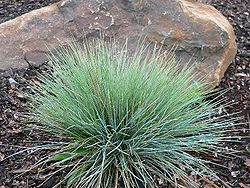Difference between revisions of "Festuca roemeri"
| Line 4: | Line 4: | ||
==Taxonomy== | ==Taxonomy== | ||
==Description== | ==Description== | ||
| − | + | Roemer’s fescue is a native cool season perennial bunchgrass with variable longevity and mostly basal foliage. It is short, fine textured, and densely tufted, and has stiff culms that grow 35-100 cm tall. The panicle (seed head) is open and 5-20 cm long. Leaves are often glaucous (covered with a whitish waxy coating) and color varies throughout a wide spectrum of greens and blues. Stem color ranges from light green to dark purple or red. | |
==Bloom Period== | ==Bloom Period== | ||
==Distribution== | ==Distribution== | ||
| Line 12: | Line 12: | ||
| − | + | It prefers moderately acid to slightly alkaline, fine to medium textured mineral soils. | |
Medium water use – While drought tolerant with extensive roots, it is found on somewhat more mesic (moist) sites such as the edges of grassy balds. As an upland grass it requires good soil drainage and does not tolerate winter soil saturation or flooding. | Medium water use – While drought tolerant with extensive roots, it is found on somewhat more mesic (moist) sites such as the edges of grassy balds. As an upland grass it requires good soil drainage and does not tolerate winter soil saturation or flooding. | ||
| − | + | The species generally grows in full sun but will tolerate partial shade near forest edges and oaks. | |
| − | + | Roemer’s fescue is a mid to late succession species in its natural habitat. | |
==Uses== | ==Uses== | ||
Revision as of 11:52, 21 May 2012
Common name: Roemer’s fescue, Bluebunch fescue, Blue bunchgrass, Bunchgrass fescue, Idaho fescue
Abbreviation Code (Codon): FERO
Contents
Taxonomy
Description
Roemer’s fescue is a native cool season perennial bunchgrass with variable longevity and mostly basal foliage. It is short, fine textured, and densely tufted, and has stiff culms that grow 35-100 cm tall. The panicle (seed head) is open and 5-20 cm long. Leaves are often glaucous (covered with a whitish waxy coating) and color varies throughout a wide spectrum of greens and blues. Stem color ranges from light green to dark purple or red.
Bloom Period
Distribution
Habitat
Rocky slopes & dry openings in woods below 5000 ft. Deep, fertile to thin, rocky soils.
It prefers moderately acid to slightly alkaline, fine to medium textured mineral soils.
Medium water use – While drought tolerant with extensive roots, it is found on somewhat more mesic (moist) sites such as the edges of grassy balds. As an upland grass it requires good soil drainage and does not tolerate winter soil saturation or flooding.
The species generally grows in full sun but will tolerate partial shade near forest edges and oaks.
Roemer’s fescue is a mid to late succession species in its natural habitat.

